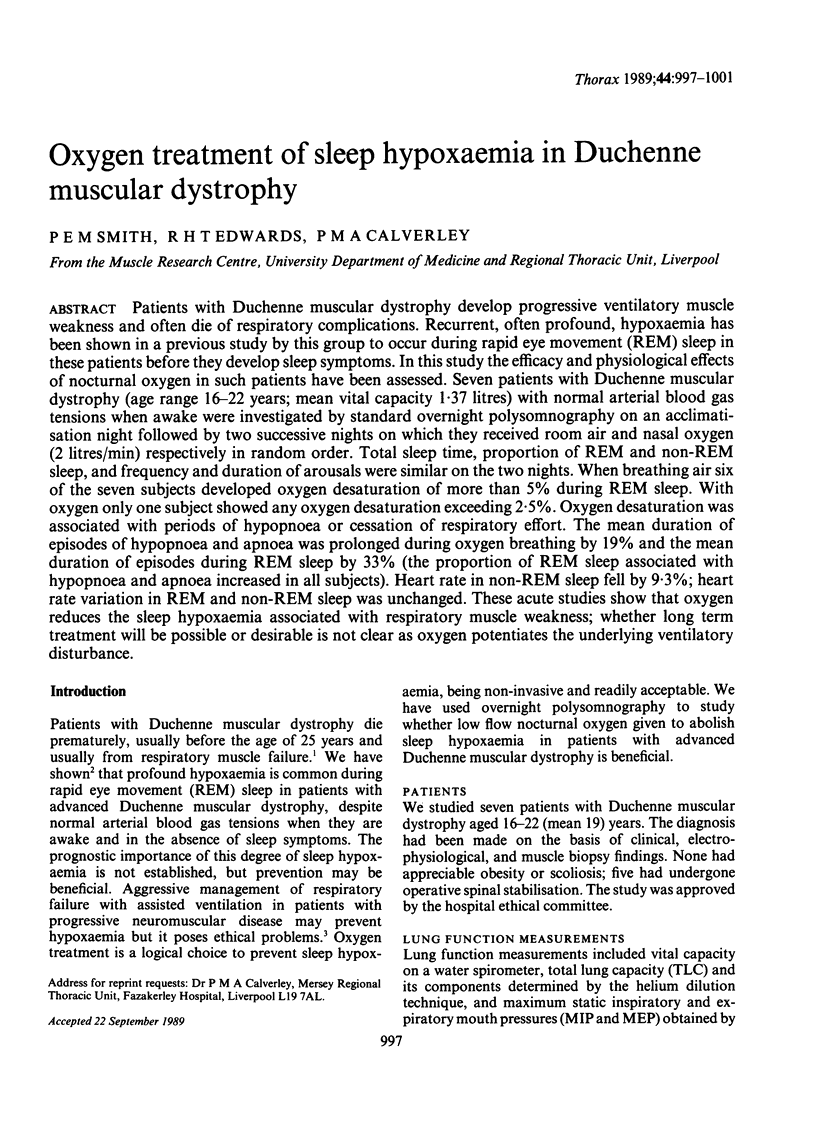Abstract
Patients with Duchenne muscular dystrophy develop progressive ventilatory muscle weakness and often die of respiratory complications. Recurrent, often profound, hypoxaemia has been shown in a previous study by this group to occur during rapid eye movement (REM) sleep in these patients before they develop sleep symptoms. In this study the efficacy and physiological effects of nocturnal oxygen in such patients have been assessed. Seven patients with Duchenne muscular dystrophy (age range 16-22 years; mean vital capacity 1.37 litres) with normal arterial blood gas tensions when awake were investigated by standard overnight polysomnography on an acclimatization night followed by two successive nights on which they received room air and nasal oxygen (2 litres/min) respectively in random order. Total sleep time, proportion of REM and non-REM sleep, and frequency and duration of arousals were similar on the two nights. When breathing air six of the seven subjects developed oxygen desaturation of more than 5% during REM sleep. With oxygen only one subject showed any oxygen desaturation exceeding 2.5%. Oxygen desaturation was associated with periods of hypopnoea or cessation of respiratory effort. The mean duration of episodes of hypopnoea and apnoea was prolonged during oxygen breathing by 19% and the mean duration of episodes during REM sleep by 33% (the proportion of REM sleep associated with hypopnoea and apnoea increased in all subjects). Heart rate in non-REM sleep fell by 9.3%; heart rate variation in REM and non-REM sleep was unchanged. These acute studies show that oxygen reduces the sleep hypoxaemia associated with respiratory muscle weakness; whether long term treatment will be possible or desirable is not clear as oxygen potentiates the underlying ventilatory disturbance.
Full text
PDF




Selected References
These references are in PubMed. This may not be the complete list of references from this article.
- Black L. F., Hyatt R. E. Maximal static respiratory pressures in generalized neuromuscular disease. Am Rev Respir Dis. 1971 May;103(5):641–650. doi: 10.1164/arrd.1971.103.5.641. [DOI] [PubMed] [Google Scholar]
- Bégin R., Bureau M. A., Lupien L., Lemieux B. Control of breathing in Duchenne's muscular dystrophy. Am J Med. 1980 Aug;69(2):227–234. doi: 10.1016/0002-9343(80)90382-4. [DOI] [PubMed] [Google Scholar]
- Fleetham J., West P., Mezon B., Conway W., Roth T., Kryger M. Sleep, arousals, and oxygen desaturation in chronic obstructive pulmonary disease. The effect of oxygen therapy. Am Rev Respir Dis. 1982 Sep;126(3):429–433. doi: 10.1164/arrd.1982.126.3.429. [DOI] [PubMed] [Google Scholar]
- Martin R. J., Sanders M. H., Gray B. A., Pennock B. E. Acute and long-term ventilatory effects of hyperoxia in the adult sleep apnea syndrome. Am Rev Respir Dis. 1982 Feb;125(2):175–180. doi: 10.1164/arrd.1982.125.2.175. [DOI] [PubMed] [Google Scholar]
- Martin R. J., Sufit R. L., Ringel S. P., Hudgel D. W., Hill P. L. Respiratory improvement by muscle training in adult-onset acid maltase deficiency. Muscle Nerve. 1983 Mar-Apr;6(3):201–203. doi: 10.1002/mus.880060306. [DOI] [PubMed] [Google Scholar]
- McNicholas W. T., Carter J. L., Rutherford R., Zamel N., Phillipson E. A. Beneficial effect of oxygen in primary alveolar hypoventilation with central sleep apnea. Am Rev Respir Dis. 1982 Jun;125(6):773–775. doi: 10.1164/arrd.1982.125.6.773. [DOI] [PubMed] [Google Scholar]
- Nuti D., Bernabei L., Federico A. Cochleovestibular investigation in progressive myoclonus epilepsy. Acta Neurol (Napoli) 1983 Feb;5(1):1–13. [PubMed] [Google Scholar]
- Rideau Y., Delaubier A. Management of respiratory neuromuscular weakness. Muscle Nerve. 1988 Apr;11(4):407–408. [PubMed] [Google Scholar]
- Smith P. E., Calverley P. M., Edwards R. H., Evans G. A., Campbell E. J. Practical problems in the respiratory care of patients with muscular dystrophy. N Engl J Med. 1987 May 7;316(19):1197–1205. doi: 10.1056/NEJM198705073161906. [DOI] [PubMed] [Google Scholar]
- Smith P. E., Calverley P. M., Edwards R. H. Hypoxemia during sleep in Duchenne muscular dystrophy. Am Rev Respir Dis. 1988 Apr;137(4):884–888. doi: 10.1164/ajrccm/137.4.884. [DOI] [PubMed] [Google Scholar]
- Smith P. L., Haponik E. F., Bleecker E. R. The effects of oxygen in patients with sleep apnea. Am Rev Respir Dis. 1984 Dec;130(6):958–963. doi: 10.1164/arrd.1984.130.6.958. [DOI] [PubMed] [Google Scholar]
- Staats B. A., Bonekat H. W., Harris C. D., Offord K. P. Chest wall motion in sleep apnea. Am Rev Respir Dis. 1984 Jul;130(1):59–63. doi: 10.1164/arrd.1984.130.1.59. [DOI] [PubMed] [Google Scholar]
- Wilson S. H., Cooke N. T., Edwards R. H., Spiro S. G. Predicted normal values for maximal respiratory pressures in caucasian adults and children. Thorax. 1984 Jul;39(7):535–538. doi: 10.1136/thx.39.7.535. [DOI] [PMC free article] [PubMed] [Google Scholar]


